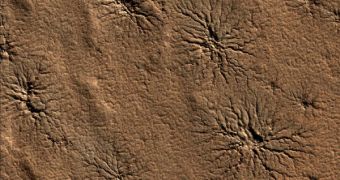New images provided by the NASA Mars Reconnaissance Orbiter (MRO) show peculiar, spider-shaped formations on the ground, near the planet's south pole, experts have recently announced. The data was collected using the High Resolution Imaging Science Experiment (HiRISE) camera aboard the space probe, which is capable of snapping amazing photos of the ground below, in great detail. Planetary scientists believe that the structures may be caused by dry ice melting and evaporating, as the dynamic, seasonal process on Mars influences the area, Space Fellowship reports.
The distinctive features were imaged on a patch of soil about 1.2 kilometers (three-quarters of a mile) wide, and experts dubbed them “araneiform,” which means spider-like in Latin. According to preliminary investigations, the structures are carved into the land, and not built upwards, above the surface. In the new picture, the Sun is about 15 degrees above the horizon, and shines from the right. The image was snapped during the southern-hemisphere summer, as evidenced by the fact that no seasonal frost can be seen in the region.
Typically, each of the channels making up the spider structures is about one to two meters (three to seven feet) deep, the science team managing HiRISE reports. The image was taken on August 23, at 87.0 degrees South latitude and 86.5 degrees East longitude. In spite of it being relatively new, scientists already have a possible explanation of how the formation may have appeared. They argue that the Red Planet's carbon-dioxide atmosphere is to be held responsible. As seasonal temperatures vary, a portion of the atmosphere condenses every winter. This results in the polar cap-like spreads of ice that astronomers discovered on both Martian poles.
When spring comes, these ice sheets sublimate, as in they turn directly from solid to gas, in a relatively short period of time (dry ice has the same behavior on the Earth too). As the gas generated at the bottom of the ice looks for ways of escaping into the atmosphere, it carves channels to locations where ice resistance is minimal. This builds up pressure under the cap, until a part of it collapses. The gas then escapes. Experts explain that, oftentimes, the area that gives way is located precisely in the center of the spider-like structures, as evidenced by their radial composition.

 14 DAY TRIAL //
14 DAY TRIAL //